Related Research Articles
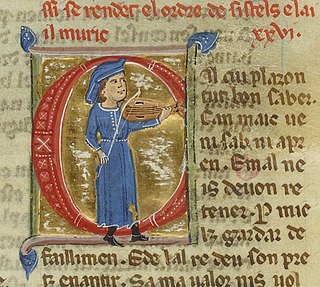
A troubadour was a composer and performer of Old Occitan lyric poetry during the High Middle Ages (1100–1350). Since the word troubadour is etymologically masculine, a female troubadour is usually called a trobairitz.

Bertran de Born was a baron from the Limousin in France, and one of the major Occitan troubadours of the twelfth century.
The sirventes or serventes, sometimes translated as "service song", was a genre of Old Occitan lyric poetry practiced by the troubadours.
Tibors de Sarenom is the earliest attestable trobairitz, active during the classical period of medieval Occitan literature at the height of the popularity of the troubadours.

The (Lo) Monge de Montaudon, born Pèire de Vic, was a nobleman, monk, and troubadour from the Auvergne, born at the castle of Vic-sur-Cère near Aurillac, where he became a Benedictine monk around 1180. According to his vida, he composed "couplets while he was in the monastery and sirventes on subjects that were popular in the region."
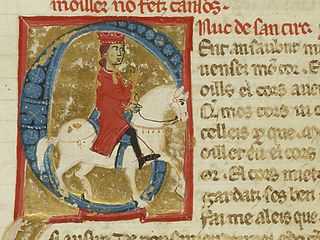
Uc de Saint Circ or Hugues (Hugh) de Saint Circq was a troubadour from Quercy. Uc is perhaps most significant to modern historians as the probable author of several vidas and razos of other troubadours, though only one of Bernart de Ventadorn exists under his name. Forty-four of his songs, including fifteen cansos and only three canso melodies, have survived, along with a didactic manual entitled Ensenhamen d'onor. According to William E. Burgwinkle, as "poet, biographer, literary historian, and mythographer, Uc must be accorded his rightful place as the 'inventor' (trobador) of 'troubadour poetry' and the idealogical trappings with which it came to be associated."
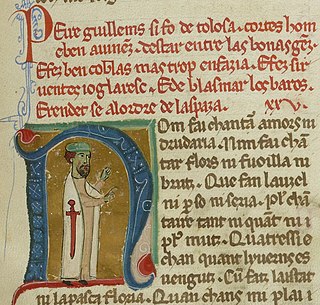
Peire Guillemde Tolosa was a 13th-century troubadour from Toulouse. Only one sirventes he wrote, a tenso with the contemporary Italian poet Sordello, survives.
Bertran d'Alamanon, also spelled de Lamanon or d'Alamano, was a Provençal knight and troubadour, and an official, diplomat, and ambassador of the court of the Count of Provence. Twenty-two of his works survive, mainly provocative tensos and sirventes, many dealing with Crusading themes.

Peire Raimon de Tolosa was a troubadour from the merchant class of Toulouse. He is variously referred to as lo Viellz and lo Gros, though these are thought by some to refer to two different persons. On the other hand, lo Viellz could refer to his being of an early generation of troubadours. Eighteen of Peire Ramon's poems survive, one canso with a melody.

Elias de Barjols was a bourgeois Aquitainian troubadour who established himself in Provence and retired a monk. Eleven of his lyrics survive, but none of his music.

Bertran del Pojet was a Provençal castellan and troubadour of the latter half of the thirteenth century, a period of Angevin rule in Provence and Italy.
Bertran Carbonel was a Provençal troubadour from Marseille. He is a polarising figure among scholars and his reputation varies between authorities. Eighteen of his lyric works survive, as well as seventy-two or ninety-four (Riquer) single coblas triadas esparsas on "edifying" themes. He was patronised at the court of Hugh IV and Henry II of Rodez.
Bertran de Born, called lo Filhs, was a Limousin knight and troubadour. He wrote two sirventes and has three other works attributed to him. He participated in the wars of John Lackland in France.
Bertran de Gourdon or Bertram de Gordon was the lord of Gourdon, a knight and troubadour.
Bertran Folcon d'Avignon or Bertran Folco d'Avinhon was a Provençal nobleman and troubadour from Avignon. He was a faithful partisan of Raymond VI and Raymond VII of Toulouse in Provence, and participated in the wars against the Albigensian Crusade. He was inside the city during the siege of Beaucaire in 1216. In 1226 Raymond VII appointed him bailiff of Avignon.
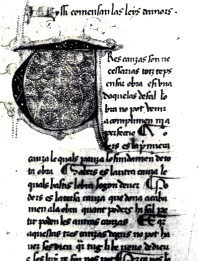
The Consistori del Gay Saber was a poetic academy founded at Toulouse in 1323 to revive and perpetuate the lyric poetry of the troubadours.
Gonzalo Ruiz or Rodríguez was the feudal lord of La Bureba throughout much of the mid-twelfth century. He held important positions at the courts of successive Castilian monarchs and guarded the frontier with Navarre, to whose Jiménez rulers he was related. He was a cultured man, with connexions to at least one, possibly two, troubadours. He may have written poetry himself, though in what language is not known.
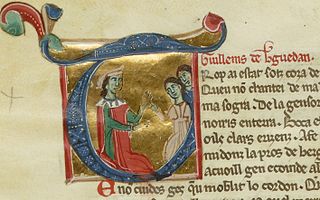
Guillem de Berguedà, or Guilhem de Berguedan in Occitan, was a Catalan troubadour and viscount of Berguedà. He was the most prolific Catalan poet of the twelfth century, though he composed in Occitan, and thirty-one of his poems survive. Most are sirventes, "typically violent and obscene, reflecting his character and turbulent life," but there are a few cansos. Most of what is known about him derives from his vida and his songs.
Bertran or Bertrán may refer to:
References
- Bibliografia Elettronica dei Trovatori, v. 2.0. Retrieved 4 October 2011.